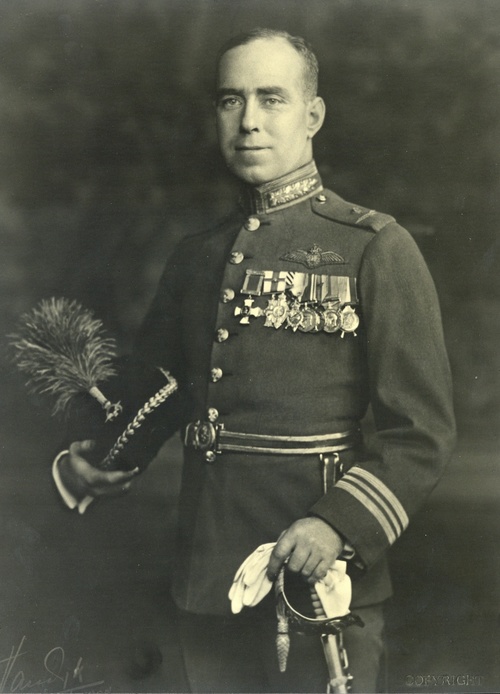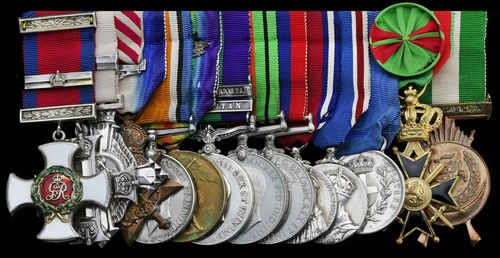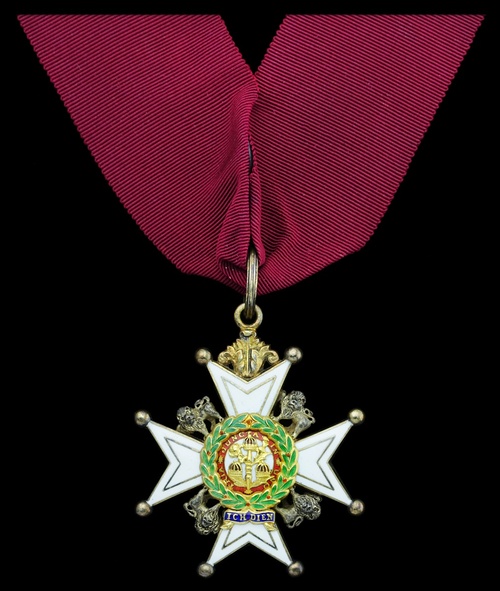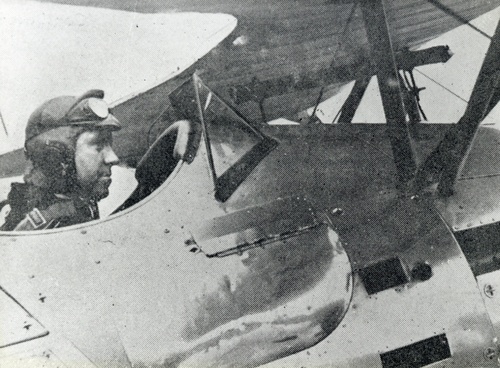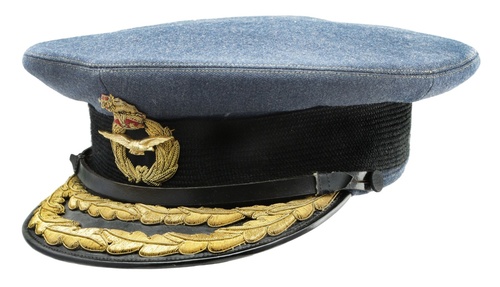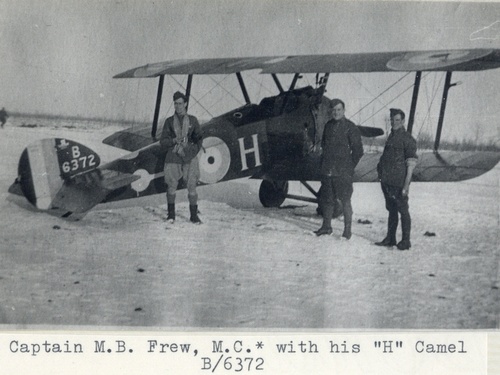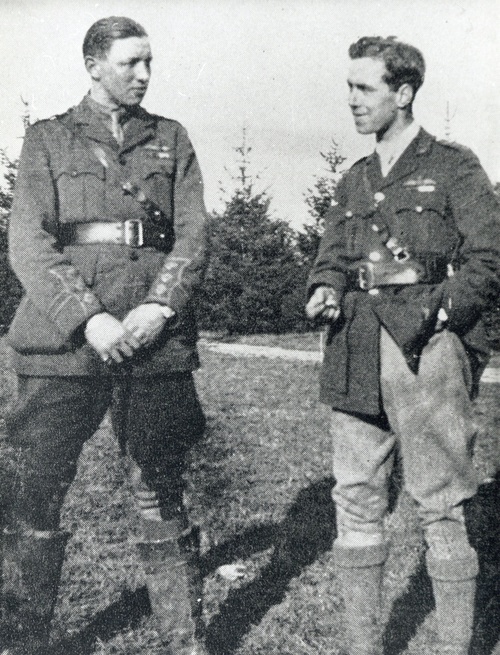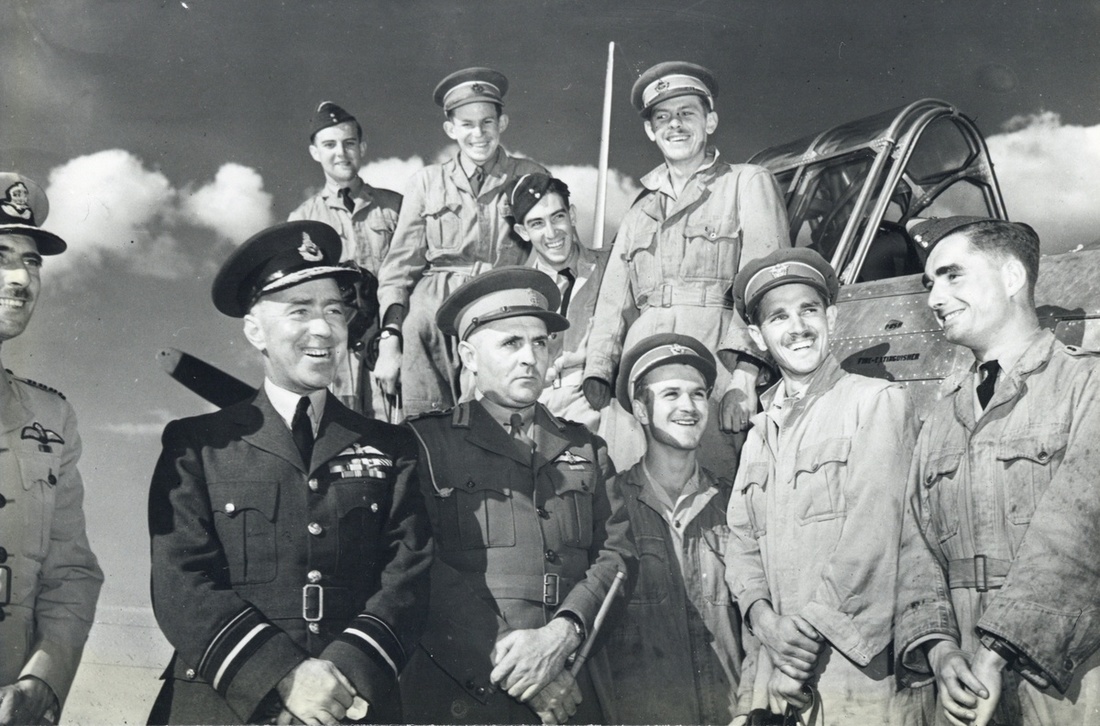Auction: 20001 - Orders, Decorations and Medals - conducted behind closed doors
Lot: 733
The exceptional and extremely rare K.B.E., Second World War C.B., Great War Ace's D.S.O. and 'Northern Kurdistan' Bar; 'French theatre' M.C. and Bar; '1919' A.F.C. group of seventeen to Air Vice-Marshal Sir Matthew Brown ´Bunty´ Frew, Royal Flying Corps and Royal Air Force, late Highland Light Infantry
As 45 Squadron's top-scoring Pilot for the Great War, Frew gained a reputation for saving his comrades at great personal risk whenever enemy aircraft got onto their tail; officially credited with 23 aerial victories, his real tally may have been far higher, since he often encouraged junior Pilots in his Squadron by giving them the credit for victories which were really his own
Frew's most remarkable victory occurred in the Italian theatre on 15 January 1918. Flying a Sopwith Camel, Frew claimed three victories that day, despite only having one gun working; on the return flight his Camel was holed by an anti-aircraft shell, and he had to glide for five miles through the barrage and over the River Piave to reach the British lines
The Most Excellent Order of the British Empire, 2nd type, Military Division, Knight Commander´s (K.B.E.) set of insignia, neck Badge, 83mm including crown suspension x 63mm, silver-gilt and enamel; Star 83mm, silver and enamel, with neck riband, in Garrard, London case of issue; The Most Honourable Order of the Bath, Military Division, Companion's (C.B.) neck Badge, 50mm, silver-gilt and enamel, with neck riband, in Garrard, London case of issue; Distinguished Service Order, G.V.R., silver-gilt and enamel, minor enamel damage, centre loose, with Second Award Bar; Military Cross, G.V.R., with Second Award Bar, unnamed as issued; Air Force Cross, G.V.R.; 1914-15 Star (3007 Pte. M.B. Frew. High: L.I.); British War and Victory Medals, with M.I.D. oak leaf (Capt. M.B. Frew), contemporarily renamed; General Service 1918-62, G.V.R., two clasps, Kurdistan, Northern Kurdistan (F/L. M.B. Frew. R.A.F.); Defence and War Medals 1939-45; Jubilee 1935; Coronation 1937; Italy, Kingdom, Al Valore Militare, silver, obverse with crowned ´Z´ and ´F.G.´ below wreath, reverse unnamed; Greece, Kingdom, Royal Order of George I, Military Division, Commander's neck Badge, 79mm including crown suspension x 46mm, silver-gilt and enamel, enamel damage to central medallion, with neck riband, in Spink & Son case of issue; Belgium, Kingdom, Military Cross, 1st Class, silver-gilt and enamel, with rosette on riband, with Fisch & Co., Bruxelles case of issue; Iraq, Kingdom, Active Service Medal, 1 clasp, 1930-31, breast awards mounted as originally worn, contact marks throughout, overall very fine (17)
K.B.E. London Gazette 1 January 1948.
C.B. London Gazette 1 January 1943.
D.S.O. London Gazette 4 March 1918:
´For conspicuous gallantry and devotion to duty. On one occasion when leader of a patrol he shot down an enemy aeroplane, two others being also accounted for in the same fight. On a later occasion he destroyed three enemy machines in one combat, all of which were seen to crash to the ground. Immediately after this combat he had to switch off his engine and make an attempt to glide towards our lines five miles away on account of his machine having received a direct hit. Owing to the great skill and courage he displayed in the handling of his damaged machine, he succeeded in bringing it safely to our lines. He has destroyed twenty-two enemy machines up to date.´
D.S.O. Second Award Bar London Gazette 6 October 1933:
´In recognition of gallant and distinguished services rendered in connection with operations in Northern Kurdistan during the period December, 1931- June, 1932.´
M.C. London Gazette 7 March 1918:
´For conspicuous gallantry and devotion to duty on patrol, showing a fine offensive spirit in many combats. He has shot down five enemy aeroplanes, on one occasion leading his formation to attack twenty-two Albatross Scouts, and himself shooting one down.´
The Recommendation, dated 22 September 1917, states:
´This officer has invariably done excellent work. He has taken part in many offensive patrols and has given proof on all occasions of the finest offensive spirit and skill in combat. He has destroyed at least five enemy aircraft and driven down out of control at least six enemy aircraft. He has led many patrols and has shown great skill in leadership, combined with cool judgement and energy. He has at all times sought out the enemy and on his own initiative on at least two occasions escorted machines of No. 20 Squadron beyond Lille on photographic work. By his magnificent work he has set a very fine example to this Squadron. I have the honour to recommend Second Lieutenant Frew for immediate recognition.´
M.C. Second Award Bar London Gazette 23 April 1918:
´For conspicuous gallantry and devotion to duty in shooting down three enemy machines in two days. He has destroyed eight enemy machines and driven down many others out of control.´
A.F.C. London Gazette 3 June 1919.
Matthew Brown Frew was born in Glasgow, Scotland in 1895. Educated at Hutcheson's Grammar School, Glasgow, he gained civilian employment with the City of Glasgow Life Insurance Company before enlisting into the 9th (Glasgow Highland) Battalion, Highland Light Infantry on 9 September 1914. He served with the Battalion on the Western Front, arriving in France on 22 January 1915. In August 1916, Frew was posted with three others from the Battalion back to England, where he volunteered for service in the Royal Flying Corps. After preliminary training he was gazetted as a Temporary Second Lieutenant (on probation) in the Royal Flying Corps on 20 October 1916, receiving elementary flying training with No. 24 Reserve Squadron at Netheravon.
The Western Front - a scrap with the 'Red Baron'
Frew's first operational posting was to 'B' Flight, No. 45 Squadron, equipped with Sopwith 1 1/2 Strutters. Frew joined this Squadron at St. Marie Cappel, France on 28 April 1917 and was soon in action. His Log Book entry for 3 May 1917 states: ´Off. Patrol. Fight with 6 Huns. Observer sick´. On 27 May 1917, Frew recorded his first aerial success: ´Off. Patrol 10 E.A. seen 1 attacked fired from front gun into one which side slipped past my r. wing and then nose dived. It was last seen going down in a nose dive´. Unfortunately the fate of this plane was never discovered, as four other enemy aircraft joined the engagement.
On 5 June, 45 Squadron carried out a daring photographic reconnaissance of Menin railway station. Frew began this action by destroying two enemy aircraft, but the Squadron suffered severe losses and Frew was lucky to escape with his life. His Log Book entry for that day confirms: ´Off. Patrol. Fought 16 E.A. 1 out of control front gun & 1 in flames & 1 out of control by Observer. Rudder & Elevator control shot through. Crash finish of 8279´. The action started at 9 a.m., with Lieutenant A. E. Charlwood leading the eight 1 1/2 Strutters through heavy flak. They successfully completed their reconnaissance mission despite being shadowed by enemy aircraft, which turned out to be a whole Jasta, led by an Albatross painted entirely in red.
Superior to the British planes in every way, the German triplanes were able to bring to bear four times the number of trainable guns as their counterparts; three of the 1 1/2 Strutters were shot down in under two minutes. A desperate running fight back to the British lines ensued. Charlwood, in possession of the photographs, luckily made it back first. Frew at one point took on four enemy aircraft simultaneously; in the ensuing mêlée he managed to find 2nd Lieutenant Norman Macmillan's aircraft, and the two of them inched west in support of each other. Frew's Strutter had sustained considerable damage, and he was forced to crash land back at St. Marie Cappel; Macmillan made it back despite severe damage. The eight aircraft of 45 Squadron had just engaged Von Richthofen's Jasta 11, led on this occasion by his brother Lothar.
The explosion of the Messines Ridge mines on 7 June heralded the start of the Battle of Messines, and Frew's squadron were hotly engaged over the battlefield. His entry for that day reveals: 'Central Off. Pat. Fought 17 E.A. 1 indecisive 1 out of control.' Frew returned to base with his controls shot away and the rear-gun out of action, but claimed another victory nine days later: ´O.P. 1 E.A. Out of Control. 1 in Flames´. He took part in offensive patrols on 21 June and 24 June, the Log Book entries for each action stating: ´1 E.A. Driven Off.´ and ´Chased 2 E.A. at Dawn but indecisive´.
In July 1917 Frew doubled his tally of aircraft destroyed; on the 16th he sent one enemy aircraft down in flames, while on the 28th he was credited with another Albatross driven down. On 31 July, as the Battle of Pilckem Ridge raged below, 45 Squadron were engaged in low-level reconnaissance patrols. When he saw two Companies of German infantry moving south-west on the Comines-Deulemont Road, Frew ´fired 1,000 rounds at the troops´. The German infantrymen returned fire, scoring several hits on Frew's aircraft.
Frew's last victory in the 1 1/2 Strutter followed on 10 August, Frew noting: ´D.O.P. 1 E.A. Shot Down. 5 Scraps.´ After a short period of leave, Frew returned in September to find that 45 Squadron had been re-equipped with single seater Sopwith Camels. Frew quickly acclimatised to this new aircraft, which he was to use with deadly effect.
A new kite
Allocated Camel B 3871, he first went up in this machine on 3 September 1917, shooting down one enemy aircraft. The next day he destroyed two enemy scouts, one of which he drove down in a spin, closely pursuing it and then firing fifty rounds into it at a range of twenty feet. Now a Patrol Leader, Frew achieved his next success on 11 September: while leading four other Camels in an offensive patrol over Westroosebeke, he encountered an enemy formation of two D.F.W. two-seaters with an escort of eight to ten Albatross Scouts. Frew immediately dived into the fray and accounted for a two-seater at close range. That same afternoon, he joined a patrol of seven Camels which engaged 21 enemy aircraft, several of which were the new Fokker Triplanes. Amongst their number was the German Air Ace Werner Voss, who claimed his 47th victim during the engagement.
On 20 September, Frew took part in three North Offensive Patrols, each in different aircraft; the following day Frew led a North Offensive Patrol of eight Camels. Frew and Brownell became separated from the other six, and were attacked over Comise at 11,000 feet by a formation of twenty of the latest 260 h.p. Albatross Scouts. In his Memoirs, Brownell later wrote of Frew as 'being full of aggression in the air and a wonderful shot, [whom] always came to the assistance of any pilot who was in trouble.' Frew's aggressive flying undoubtedly saved both pilots' lives, and was a testament to his bravery and espirit de corps in action. He drove one of the enemy planes down and then dived onto another which was attacking Brownell´s aircraft from behind; with two bursts of about forty to fifty rounds, Frew brought this second machine spiralling down in flames, to crash near Comines. The day after this exploit Frew's commanding officer, Major A.M. Vacour, recommended him for a decoration; Frew was awarded the M.C. in the field five days later.
On 5 October, Frew's plane B 3871 was badly damaged in a forced landing, and he was assigned another aircraft four days later. He immediately went up on patrol in it and on seeing a large trench packed with enemy troops (south-east of Gheluvelt), he fired 300 rounds into it from a height of 600 feet. On 10 October Frew accounted for another two enemy aircraft; two days later the first Battle of Passchendaele began. More ground strafing sorties followed, and on 13 October Frew silenced a four-gun anti-aircraft battery. Brownell's Memoirs reveal that due to the bad weather there were no enemy aircraft to engage, but there was a German anti-aircraft battery at Comines that fired relentlessly at passing British planes. Frew and his patrol of three other Camels swept down on this battery and fired a few long bursts at low altitude; they would then pull up rapidly and repeat the process. In this way the battery was eventually silenced.
Frew added to his score on 21 October when leading a six-machine North Offensive Patrol; the British patrol dived on four German two-seaters only to be set upon by three formations, each of seven Albatross Scouts. The British Patrol took first blood, with an Albatross going down near Lille, but Frew then noticed an enemy Scout on the tail of one of his Patrol's planes. Despite the fact that he was being attacked by several other enemy Scouts, Frew immediately dived to shoot it off, thereby saving his comrade. On the same patrol he had indecisive combats with another six enemy aircraft. Frew's impressive record earned him promotion to 'B' Flight Commander and temporary Captain on 24 October.
Two days later the Second Battle of Passchendaele began. After carrying out several deadly ground strafes, Frew shared a Junker two-seater with Lieutenant K.B. Montgomery. The next day Frew gained his last victories over the French theatre of war, the Log Book attesting '1 crashed 1 in flames'. This action unfolded as follows: two formations of five Camels each, one led by Frew, went to the aid of three R.E.8s who were under heavy attack; Frew sent one Albatross down, only to realise that he was isolated and therefore the subject of attention of eight enemy aircraft. Frew somehow managed, by employing every imaginable manoeuvre, to hold his own until the other half of the patrol rejoined the fray; now six versus eight, Frew and his comrades went on the attack, quickly sending an Albatross down in flames. He then noticed a Camel at about 3,000 to 4,000 feet going down smoking and being sorely pressed by three enemy Scouts which were firing into it; Frew immediately dived right down amongst the enemy machines and, singling out the most aggressive, fired about twenty rounds into it from a range of fifteen feet - it burst into flames and crashed east of Moorslede. The remaining two Scouts refused combat with him and dived east.
Frew took part in his last combats over France on 31 October. During his time there he had accounted for 19 enemy aircraft, of which eight had been destroyed (either in flames or crashed), nine had been driven down out of control, and two had been driven down. On 3 November he was awarded a Bar to his Military Cross.
Further Victories in Italy
Numbers 28, 34, 42, 45 and 66 Squadrons were sent to Italy at the end of 1917, forming Webb-Bowen's VII Brigade, Royal Flying Corps. Based at Istrana, 45 Squadron undertook an offensive patrol on 27 December 1917. The Squadron was mainly tasked with offensive patrols and bomber escorts, especially with 34 (Bomber) Squadron, also based at Istrana. Frew arrived in Italy on 11 January 1918, and three days later, whilst trying to catch up with an Eastern Patrol, he spotted four 260 h.p. Albatrosses in the vicinity of Susegana. The leader´s machine was painted entirely red and the others all had red propeller bosses; Frew attacked the red leader from underneath and fired about 200 rounds into the machine at 100 feet range. The red aircraft went down in a spin but Frew followed it and fired a further 50 rounds into its fuselage. Frew did not have time to follow it as he was attacked by the other three aircraft; despite his Aldis sight being blown back into his face he counter-attacked and chased the other planes off over the mountains.
'Bunty's' finest hour occurred on 15 January 1918. His Log Book entry for that date simply states ´1 crashed. 3 in flames´, only hinting at the monumental piece of flying which took place over Rai San Vazzola. Leading a patrol of three Camels (the other pilots being Black and Carpenter), at 10.30 a.m. Frew observed a D.F.W. two-seater, protected by four Albatross DV Scouts, doing a reconnaissance patrol on the British side of the lines. Frew led his Camels to a position from whence they could intercept the formation upon its return. Using the sun as cover, he dived down from 12,000 feet on the D.F.W. two-seater, which with one of the Scouts was flying higher than the other three. After firing only about four shots from point blank range (with just one gun working), Frew sent the two-seater down in flames. In the meantime, Carpenter accounted for one of the enemy scouts and saw it crash near Frew´s victim at Rai San Vazzola; one of Frew's guns had a stoppage which he was unable to clear, but nevertheless he attacked two enemy aircraft and succeeded in shooting both down in turn. Carpenter was then seen by Frew to be attacking another Albatross nose-on; as the two machines were on the point of colliding, the enemy machine turned and tried to get onto the tail of Carpenter´s Camel; Frew then dived about 1,000 feet onto the Albatross and shot it down, apparently completely out of control; this machine was last seen in a spin about 50 feet from the ground, but it flattened out and succeeded in escaping Frew as he had run out of ammunition.
Frew collected his formation and started for home, but enemy anti-aircraft guns immediately opened up on the three Camels, which were still about five miles from the British lines, and flying at a height of 3,000 feet. Frew's machine received a direct hit from an anti-aircraft shell and was severely damaged; the rear main plane connecting rod was severed allowing its rear spar to tilt upward, the adjacent centre section was damaged and a wheel was shot off. Frew immediately shut off his engine to reduce the strain on his ruptured aircraft and glided towards home. The anti-aircraft gunners put up barrage after barrage but he glided through. A new danger then appeared in the shape of the River Piave, and his plight once again seemed hopeless. His machine was too close to the ground and the river had to be crossed. Accepting the risk that turning his engine on again might break up his aircraft, he decided to give it a go; the short burst of engine power gave him just enough to skim over the river and make a forced landing just behind the Italian front line at Saletto.
As a result of this incredible sortie, Frew was awarded the Distinguished Service Order. Having displaced his neck during the combat, he was unable to fly for a week. He added another Albatross to his victories on 27 January, before accounting for two enemy machines, including the enemy formation's leader, in a fierce twenty minute scrap on 14 February. Frew's neck had not fully recovered, and on 8 February he was examined by the Wing Medical Officer. Ordered to return to Home Establishment, Frew was distraught to be leaving the Squadron, but by the end of the Great War he still remained as 45 Squadron's top scoring pilot.
Officially credited with 23 victories, other sources vary from 30 upwards and Peter Carpenter, one of the pilots who flew with Frew, later stated that he believed Frew shot down twice the number he was credited with, due to the fact that whenever he took a new pilot over the lines he would give the newcomer the credit for any machines shot down, even though it had been Frew himself who had been responsible for the destruction of the enemy plane. Frew´s Log Book for the Great War certainly lends weight to a larger haul. Brownell´s Memoirs add a different perspective in that on many occasions and sometimes against overwhelming odds, Frew saved members of the squadron, including Brownell, by shooting enemy aircraft off them when they were almost certain to be shot down; he goes further in saying that many of Frew's Squadron contemporaries were of the opinion that he should have been awarded the V.C. on several occasions for his intrepid 'saves'.
Later Career
Appointed to the Air Ministry, Frew took up the much-vaunted position of Chief Fighter Instructor at the Central Flying School, Upavon on 19 June 1918. It was in this capacity that he was awarded the Air Force Cross. On 12 June 1919 Frew attended an Investiture in the Quadrangle of Buckingham Palace, where King George V invested him with the D.S.O., M.C. and Bar. He returned on 24 July to receive his Air Force Cross. In 1922 Frew was posted as Flight Commander to No. 6 Squadron, equipped with Bristol Fighters. Operating from Baghdad, this Squadron supported the campaign against the Kurdish Chief Sheik Mahmoud. In 1923 Frew became an Instructor at the Armament and Gunnery School, R.A.F. Eastchurch. He advanced to Squadron Leader in 1927, and was then appointed Chief Fighter Instructor at No.1 F.T. School.
In June 1931, Frew was posted to Air Staff, Operations H.Q. Iraq, where he played a vital role in the Northern Kurdistan campaign. In March 1932 he was given command of No. 30 (Bomber) Squadron, of which one flight was equipped with Wapiti aircraft. Frew led this Flight in a mission to support a column of Iraqi troops which advanced from Balikian against Sheik Ahmed´s Kurdish tribesmen. A Flight of the Iraqi Air Force operated from Diana in support. Frew's Flight shadowed the Iraqi column continuously between 15 March and 22 April. On 3 April, the column was ambushed by a strong force of Kurds, and only saved only by the energy and gallantry of the British officers on the ground, and by the intervention of Frew's Flight. Frew and his pilots flew at tree-top level throughout the day, dropping bombs on the rebels continuously until they withdrew at nightfall. Frew´s Log Book entry for that date reads: 'Badly Shot Up. Main Petrol Pipe and Tanks.' One pilot of Frew's Flight died of wounds, an Observer was wounded, and most of the aircraft were badly damaged by enemy rifle fire from the ground. Frew was awarded a Bar to his Distinguished Service Order for this campaign (one of only three D.S.O.s awarded for Northern Kurdistan).
Frew served as Officer Commanding No. 111 Squadron, equipped with Bristol Bulldogs, at Hornchurch from May 1933 to August 1934. He served in the same capacity with No. 10 Squadron, being promoted Wing Commander in late 1934. Appointed Officer Commanding R.A.F. Hornchurch in 1938, the outbreak of the Second World War saw Frew promoted to Group Captain, Senior Air Staff Officer No. 23 (Training) Group, Grantham. After a brief period in command of the R.A.F. Station at North Weald, Frew was appointed Head of the R.A.F. Mission and Director of Air Training in South Africa on 19 September 1940. His main responsibility in these appointments was the administration of the Commonwealth Air Training Scheme in South Africa, which trained aircrew not only for the R.A.F. and the S.A.A.F. but also for the Air Forces of other Allied countries. This accounts for his award of the Greek Royal Order of George I and the Belgian Military Cross, in addition to his K.B.E. and C.B. sets of Insignia. Frew retired with the rank of Air Vice-Marshal on 19 December 1948 and settled in Pretoria, South Africa. He died there on 28 May 1974.
Sold with the following:
(i)
Air Vice-Marshal´s R.A.F. cap, by Gieves Ltd, named on the inside 'A.V.M. M.B. Frew' (illustrated)
(ii)
Seven Pilot´s Flying Log Books (16.12.1916-4.2.1918; 7.2.1922-29.9.1923; 16.11.1923-26.2.1925; 2.3.1925-31.5.1927; 7.6.1927-22.5.1931; 17.6.1931-5.3.1933; 12.5.1933-January 1948), two being Army Book 425 types, and one being his personal ´Desert´ Log Book covering the period 7.2.1922-29.9.1923.
(iii)
Commission Warrant appointing M.B. Frew as Temporary Captain, R.A.F., with effect from 1.4.1918, dated 1.11.1918 - Commission appointing M.B. Frew as Flight Lieutenant, R.A.F., with effect from 24.10.1919, dated 1.12.1919.
(iv)
Bestowal Document for the Most Excellent Order of the British Empire, Military Division, K.B.E., dated 1.1.1948, with enclosure letter; Bestowal Document for the Most Honourable Order of the Bath, Military Division, C.B., dated 1.1.1943, with enclosure letter; Bestowal Document for the Distinguished Service Order, dated 4.3.1918; Bestowal Document for the Al Valore Militaire, dated 21.7.1921; Bestowal Document for the Belgian Military Cross, dated 16.3.1945, with enclosure letter and additional letter of congratulation from Général-Major Gilliaert, dated 2.6.1945; Bestowal Document for the Greek Royal Order of George I, dated 21.5.1943; M.I.D. Certificate, dated 18.4.1918; Certificate and enclosure letter for Jubilee 1935 Medal; Certificate and enclosure letter for Coronation 1937 Medal.
(v)
Royal Flying Corps (Officers) Graduation Certificate (No.3864), dated 6.4.1917; two letters from Arthur Henderson (later Baron Rowley), Secretary of State for Air, on the occasion of Frew's retirement, both dated 1.9.1948 - 59; letters and telegrams of congratulation on the occasion of the award of Frew's K.B.E., correspondents include: Marshal of the Royal Air Force The Right Hon. the Lord Tedder of Glenguin, Air Chief Marshal Sir Basil Embry, Air Chief Marshal Sir Ralph Cochrane, Field Marshal J.C. Smuts, Air Vice-Marshals Carnegie, McBurney and Mclaren, Sir Evelyn Baring and the prominent R.A.F. Historian Group Captain Kingsley Oliver.
(vi)
Five Letters of Condolence to Lady Frew on the death of her husband and one addressed to her son; a large portrait photograph of Frew in uniform; three Large albums of copy photographs and press cuttings covering various stages of Frew´s career.
For the recipient's mounted group of dress miniatures, see Lot 1173.
Subject to 20% VAT on Buyer’s Premium. For more information please view Terms and Conditions for Buyers.
Sold for
£35,000
Starting price
£18000

